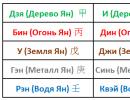Differentiating complex and implicit functions of several arguments. §6 Partial derivatives of complex functions of several variables. Extremum of a function of two variables
We will learn to find derivatives of functions specified implicitly, that is, specified by certain equations connecting variables x And y. Examples of functions specified implicitly:
![]() ,
,
Derivatives of functions specified implicitly, or derivatives of implicit functions, are found quite simply. Now let’s look at the corresponding rule and example, and then find out why this is needed at all.
In order to find the derivative of a function specified implicitly, you need to differentiate both sides of the equation with respect to x. Those terms in which only X is present will turn into the usual derivative of the function from X. And the terms with the game must be differentiated using the rule for differentiating a complex function, since the game is a function of X. To put it quite simply, the resulting derivative of the term with x should result in: the derivative of the function from the y multiplied by the derivative from the y. For example, the derivative of a term will be written as , the derivative of a term will be written as . Next, from all this, you need to express this “game stroke” and the desired derivative of the function specified implicitly will be obtained. Let's look at this with an example.
Example 1.
Solution. We differentiate both sides of the equation with respect to x, assuming that i is a function of x:
From here we get the derivative that is required in the task:
Now something about the ambiguous property of functions specified implicitly, and why special rules for their differentiation are needed. In some cases, you can verify that the substitution in given equation(see examples above) instead of y, its expression through x leads to the fact that this equation turns into an identity. So. The above equation implicitly defines the following functions:
After substituting the expression for the squared game through x into the original equation, we obtain the identity:
![]() .
.
The expressions that we substituted were obtained by solving the equation for the game.
If we were to differentiate the corresponding explicit function
then we would get the answer as in example 1 - from a function specified implicitly:
But not every function specified implicitly can be represented in the form y = f(x) . So, for example, the implicitly specified functions
![]()
are not expressed through elementary functions, that is, these equations cannot be solved with respect to the player. Therefore, there is a rule for differentiating a function specified implicitly, which we have already studied and will further consistently apply in other examples.
Example 2. Find the derivative of a function given implicitly:
![]() .
.
We express the prime and - at the output - the derivative of the function specified implicitly:
Example 3. Find the derivative of a function given implicitly:
![]() .
.
Solution. We differentiate both sides of the equation with respect to x:
 .
.
Example 4. Find the derivative of a function given implicitly:
![]() .
.
Solution. We differentiate both sides of the equation with respect to x:
![]() .
.
We express and obtain the derivative:
 .
.
Example 5. Find the derivative of a function given implicitly:
Solution. We move the terms on the right side of the equation to the left side and leave zero on the right. We differentiate both sides of the equation with respect to x.
A function Z= f(x; y) is called implicit if it is given by the equation F(x,y,z)=0 unresolved with respect to Z. Let us find the partial derivatives of the function Z given implicitly. To do this, substituting the function f(x;y) into the equation instead of Z, we obtain the identity F(x,y, f(x,y))=0. Partial derivatives of a function, identically equal to zero, are also equal to zero.
 F(x,y, f (x, y)) =
F(x,y, f (x, y)) =  =0 (considered constant)
=0 (considered constant)
 F(x,y, f (x, y)) =
F(x,y, f (x, y)) =  =0 (xconsidered constant)
=0 (xconsidered constant)
Where  And
And 
Example: Find the partial derivatives of the function Z given by the equation  .
.
Here F(x,y,z)=  ;
;
 ;
;
 ;
;
 . According to the formulas given above we have:
. According to the formulas given above we have:
 And
And 
Directional derivative
Let a function of two variables Z= f(x; y) be given in a certain neighborhood of the point M (x,y). Consider some direction defined by the unit vector  , Where
, Where  (see picture).
(see picture).
On a straight line passing in this direction through point M, we take point M 1 (  ) so that the length
) so that the length  segmentMM 1 is equal to
segmentMM 1 is equal to  . The increment of the function f(M) is determined by the relation, where
. The increment of the function f(M) is determined by the relation, where  connected by relationships. Ratio limit
connected by relationships. Ratio limit  at
at  will be called the derivative of the function
will be called the derivative of the function  at the point
at the point  in the direction
in the direction  and be designated
and be designated  .
.
 =
=

If the function Z is differentiable at the point  , then its increment at this point taking into account the relations for
, then its increment at this point taking into account the relations for  can be written in the following form.
can be written in the following form.
dividing both parts by 
and passing to the limit at  we obtain a formula for the derivative of the function Z= f(x; y) in the direction:
we obtain a formula for the derivative of the function Z= f(x; y) in the direction:

Gradient
Consider a function of three variables  differentiable at some point
differentiable at some point  .
.
The gradient of this function  at point M is a vector whose coordinates are respectively equal to the partial derivatives
at point M is a vector whose coordinates are respectively equal to the partial derivatives  at this point. To indicate a gradient, use the symbol
at this point. To indicate a gradient, use the symbol  .
. =
=

 .
.
 .The gradient indicates the direction of the fastest growth of the function at a given point.
.The gradient indicates the direction of the fastest growth of the function at a given point.
Since the unit vector  has coordinates (
has coordinates (  ), then the directional derivative for the case of a function of three variables is written in the form, i.e.
), then the directional derivative for the case of a function of three variables is written in the form, i.e.  has the formula for the scalar product of vectors
has the formula for the scalar product of vectors  And
And  . Let's rewrite the last formula as follows:
. Let's rewrite the last formula as follows:
 , Where
, Where  - angle between vector
- angle between vector  And
And  . Since
. Since  , then it follows that the derivative of the function in direction takes the max value at
, then it follows that the derivative of the function in direction takes the max value at  =0, i.e. when the direction of the vectors
=0, i.e. when the direction of the vectors  And
And  match. At the same time
match. At the same time  That is, in fact, the gradient of a function characterizes the direction and magnitude of the maximum rate of increase of this function at a point.
That is, in fact, the gradient of a function characterizes the direction and magnitude of the maximum rate of increase of this function at a point.
Extremum of a function of two variables
The concepts of max, min, extremum of a function of two variables are similar to the corresponding concepts of a function of one variable. Let the function Z= f(x; y) be defined in some domain D, etc. M  belongs to this area. Point M
belongs to this area. Point M  is called the max point of the function Z= f(x; y) if there is such a δ-neighborhood of the point
is called the max point of the function Z= f(x; y) if there is such a δ-neighborhood of the point  , that for each point from this neighborhood the inequality
, that for each point from this neighborhood the inequality  . The point min is determined in a similar way, only the inequality sign will change
. The point min is determined in a similar way, only the inequality sign will change  . The value of the function at the point max(min) is called maximum (minimum). The maximum and minimum of a function are called extrema.
. The value of the function at the point max(min) is called maximum (minimum). The maximum and minimum of a function are called extrema.
Necessary and sufficient conditions for an extremum
Theorem:(Necessary conditions for an extremum). If at point M  the differentiable function Z= f(x; y) has an extremum, then its partial derivatives at this point are equal to zero:
the differentiable function Z= f(x; y) has an extremum, then its partial derivatives at this point are equal to zero:  ,
, .
.
Proof: Having fixed one of the variables x or y, we transform Z = f(x; y) into a function of one variable, for the extremum of which the above conditions must be met. Geometrically equalities  And
And  mean that at the extremum point of the function Z= f(x; y), the tangent plane to the surface representing the function f(x,y)=Z is parallel to the OXY plane, because the equation of the tangent plane is Z = Z 0. The point at which the first-order partial derivatives of the function Z = f (x; y) are equal to zero, i.e.
mean that at the extremum point of the function Z= f(x; y), the tangent plane to the surface representing the function f(x,y)=Z is parallel to the OXY plane, because the equation of the tangent plane is Z = Z 0. The point at which the first-order partial derivatives of the function Z = f (x; y) are equal to zero, i.e.  ,
, , are called the stationary point of the function. A function can have an extremum at points where at least one of the partial derivatives does not exist. For exampleZ=|-
, are called the stationary point of the function. A function can have an extremum at points where at least one of the partial derivatives does not exist. For exampleZ=|-  | has max at the point O(0,0), but has no derivatives at this point.
| has max at the point O(0,0), but has no derivatives at this point.
Stationary points and points at which at least one partial derivative does not exist are called critical points. At critical points, the function may or may not have an extremum. The equality of partial derivatives to zero is a necessary but not sufficient condition for the existence of an extremum. For example, when Z=xy, point O(0,0) is critical. However, the function Z=xy does not have an extremum in it. (Because in the I and III quarters Z>0, and in the II and IV – Z<0). Таким образом для нахождения экстремумов функции в данной области необходимо подвергнуть каждую критическую точку функции дополнительному исследованию.
Theorem: (Sufficient condition for extrema). Let at a stationary point  and in a certain neighborhood the function f(x; y) has continuous partial derivatives up to the 2nd order inclusive. Let's calculate at the point
and in a certain neighborhood the function f(x; y) has continuous partial derivatives up to the 2nd order inclusive. Let's calculate at the point  values
values  ,
, And
And 
 . Let's denote
. Let's denote


In case  , extremum at point
, extremum at point  it may or may not be. More research is needed.
it may or may not be. More research is needed.
As is known, an implicitly given function of one variable is defined as follows: the function y of the independent variable x is called implicit if it is given by an equation that is not resolved with respect to y:
Example 1.11.
Equation

implicitly specifies two functions:
And the equation

does not specify any function.
Theorem 1.2 (existence implicit function).
Let the function z =f(x,y) and its partial derivatives f"x and f"y be defined and continuous in some neighborhood UM0 of the point M0(x0y0). In addition, f(x0,y0)=0 and f"(x0,y0)≠0, then equation (1.33) defines in the neighborhood of UM0 an implicit function y= y(x), continuous and differentiable in some interval D with center at point x0, and y(x0)=y0.
No proof.
From Theorem 1.2 it follows that on this interval D:
that is, there is an identity in
where the “total” derivative is found according to (1.31)
That is, (1.35) gives the formula for finding the derivative implicitly given function one variable x.
An implicit function of two or more variables is defined similarly.
For example, if in some region V of Oxyz space the equation holds:
then under certain conditions on the function F it implicitly defines the function
![]()
Moreover, by analogy with (1.35), its partial derivatives are found as follows:

Example 1.12. Assuming that the equation
implicitly defines a function
![]()
find z"x, z"y.

therefore, according to (1.37), we get the answer.

11.Use of partial derivatives in geometry.
12.Extrema of a function of two variables.
The concepts of maximum, minimum, and extremum of a function of two variables are similar to the corresponding concepts of a function of one independent variable (see section 25.4).
Let the function z = ƒ(x;y) be defined in some domain D, point N(x0;y0) О D.
A point (x0;y0) is called a maximum point of the function z=ƒ(x;y) if there is a d-neighborhood of the point (x0;y0) such that for each point (x;y) different from (xo;yo), from this neighborhood the inequality ƒ(x;y) holds<ƒ(хо;уо).
A  The minimum point of the function is determined in a similar way: for all points (x; y) other than (x0; y0), from the d-neighborhood of the point (xo; yo) the following inequality holds: ƒ(x; y)>ƒ(x0; y0).
The minimum point of the function is determined in a similar way: for all points (x; y) other than (x0; y0), from the d-neighborhood of the point (xo; yo) the following inequality holds: ƒ(x; y)>ƒ(x0; y0).
In Figure 210: N1 is the maximum point, and N2 is the minimum point of the function z=ƒ(x;y).
The value of the function at the point of maximum (minimum) is called the maximum (minimum) of the function. The maximum and minimum of a function are called its extrema.
Note that, by definition, the extremum point of the function lies inside the domain of definition of the function; maximum and minimum have a local (local) character: the value of the function at the point (x0; y0) is compared with its values at points sufficiently close to (x0; y0). In region D, a function may have several extrema or none.
46.2. Necessary and sufficient conditions extremum
Let us consider the conditions for the existence of an extremum of a function.
Theorem 46.1 (necessary conditions for an extremum). If at the point N(x0;y0) the differentiable function z=ƒ(x;y) has an extremum, then its partial derivatives at this point are equal to zero: ƒ"x(x0;y0)=0, ƒ"y(x0;y0 )=0.
Let's fix one of the variables. Let us put, for example, y=y0. Then we obtain a function ƒ(x;y0)=φ(x) of one variable, which has an extremum at x = x0. Therefore, according to the necessary condition for the extremum of a function of one variable (see section 25.4), φ"(x0) = 0, i.e. ƒ"x(x0;y0)=0.
Similarly, it can be shown that ƒ"y(x0;y0) = 0.
Geometrically, the equalities ƒ"x(x0;y0)=0 and ƒ"y(x0;y0)=0 mean that at the extremum point of the function z=ƒ(x;y) the tangent plane to the surface representing the function ƒ(x;y) ), is parallel to the Oxy plane, since the equation of the tangent plane is z=z0 (see formula (45.2)).
Z  note. A function can have an extremum at points where at least one of the partial derivatives does not exist. For example, the function
note. A function can have an extremum at points where at least one of the partial derivatives does not exist. For example, the function ![]() has a maximum at the point O(0;0) (see Fig. 211), but does not have partial derivatives at this point.
has a maximum at the point O(0;0) (see Fig. 211), but does not have partial derivatives at this point.
The point at which the first order partial derivatives of the function z ≈ ƒ(x; y) are equal to zero, i.e. f"x=0, f"y=0, is called a stationary point of the function z.
Stationary points and points at which at least one partial derivative does not exist are called critical points.
At critical points, the function may or may not have an extremum. The equality of partial derivatives to zero is a necessary but not sufficient condition for the existence of an extremum. Consider, for example, the function z = xy. For it, the point O(0; 0) is critical (at it z"x=y and z"y - x vanish). However, the function z=xy does not have an extremum in it, since in a sufficiently small neighborhood of the point O(0; 0) there are points for which z>0 (points of the first and third quarters) and z< 0 (точки II и IV четвертей).
Thus, to find the extrema of a function in a given area, it is necessary to subject each critical point of the function to additional research.
Theorem 46.2 (sufficient condition for an extremum). Let the function ƒ(x;y) at a stationary point (xo; y) and some of its neighborhood have continuous partial derivatives up to the second order inclusive. Let us calculate at the point (x0;y0) the values A=f""xx(x0;y0), B=ƒ""xy(x0;y0), C=ƒ""yy(x0;y0). Let's denote

1. if Δ > 0, then the function ƒ(x;y) at the point (x0;y0) has an extremum: maximum if A< 0; минимум, если А > 0;
2. if Δ< 0, то функция ƒ(х;у) в точке (х0;у0) экстремума не имеет.
In the case of Δ = 0, there may or may not be an extremum at the point (x0;y0). More research is needed.
TASKS
1.
Example. Find the intervals of increasing and decreasing function. Solution. The first step is finding the domain of definition of a function. In our example, the expression in the denominator should not go to zero, therefore, . Let's move on to the derivative function:  To determine the intervals of increase and decrease of a function based on a sufficient criterion, we solve inequalities on the domain of definition. Let's use a generalization of the interval method. The only real root of the numerator is x = 2, and the denominator goes to zero at x = 0. These points divide the domain of definition into intervals in which the derivative of the function retains its sign. Let's mark these points on the number line. We conventionally denote by pluses and minuses the intervals at which the derivative is positive or negative. The arrows below schematically show the increase or decrease of the function on the corresponding interval.
To determine the intervals of increase and decrease of a function based on a sufficient criterion, we solve inequalities on the domain of definition. Let's use a generalization of the interval method. The only real root of the numerator is x = 2, and the denominator goes to zero at x = 0. These points divide the domain of definition into intervals in which the derivative of the function retains its sign. Let's mark these points on the number line. We conventionally denote by pluses and minuses the intervals at which the derivative is positive or negative. The arrows below schematically show the increase or decrease of the function on the corresponding interval.  Thus,
Thus,  And
And  . At the point x = 2 the function is defined and continuous, so it should be added to both the increasing and decreasing intervals. At the point x = 0 the function is not defined, so we do not include this point in the required intervals. We present a graph of the function to compare the results obtained with it.
. At the point x = 2 the function is defined and continuous, so it should be added to both the increasing and decreasing intervals. At the point x = 0 the function is not defined, so we do not include this point in the required intervals. We present a graph of the function to compare the results obtained with it.  Answer: the function increases with
Answer: the function increases with ![]() , decreases on the interval (0;
2]
.
, decreases on the interval (0;
2]
.
2.
Examples.
Set the intervals of convexity and concavity of a curve y = 2 – x 2 .
We'll find y"" and determine where the second derivative is positive and where it is negative. y" = –2x, y"" = –2 < 0 на (–∞; +∞), следовательно, функция всюду выпукла.
y = e x. Because y"" = e x > 0 for any x, then the curve is concave everywhere.



y = x 3 . Because y"" = 6x, That y"" < 0 при x < 0 и y"" > 0 at x> 0. Therefore, when x < 0 кривая выпукла, а при x> 0 is concave.
3.



4. Given the function z=x^2-y^2+5x+4y, vector l=3i-4j and point A(3,2). Find dz/dl (as I understand it, the derivative of the function with respect to the direction of the vector), gradz(A), |gradz(A)|. Let's find the partial derivatives: z(with respect to x)=2x+5 z(with respect to y)=-2y+4 Let's find the values of the derivatives at point A(3,2): z(with respect to x)(3,2)=2*3+ 5=11 z(by y)(3,2)=-2*2+4=0 From where, gradz(A)=(11,0)=11i |gradz(A)|=sqrt(11^2+0 ^2)=11 Derivative of the function z in the direction of the vector l: dz/dl=z(in x)*cosa+z(in y)*cosb, a, b-angles of the vector l with the coordinate axes. cosa=lx/|l|, cosb=ly/|l|, |l|=sqrt(lx^2+ly^2) lx=3, ly=-4, |l|=5. cosa=3/5, cosb=(-4)/5. dz/dl=11*3/5+0*(-4)/5=6.6.
Very often, when solving practical problems (for example, in higher geodesy or analytical photogrammetry), complex functions of several variables appear, i.e. arguments x, y, z one function f(x,y,z) ) are themselves functions of new variables U, V, W ).
This, for example, happens when moving from a fixed coordinate system Oxyz into the mobile system O 0 UVW and back. In this case, it is important to know all the partial derivatives with respect to the “fixed” - “old” and “moving” - “new” variables, since these partial derivatives usually characterize the position of an object in these coordinate systems, and, in particular, affect the correspondence of aerial photographs to a real object . In such cases, the following formulas apply:
That is, a complex function is given T three "new" variables U, V, W through three "old" variables x, y, z, Then:

Comment. There may be variations in the number of variables. For example: if


In particular, if z = f(xy), y = y(x) , then we get the so-called “total derivative” formula:
The same formula for the “total derivative” in the case of:
will take the form:
Other variations of formulas (1.27) - (1.32) are also possible.
Note: the “total derivative” formula is used in the physics course, section “Hydrodynamics” when deriving the fundamental system of equations of fluid motion.
Example 1.10. Given:
According to (1.31):


§7 Partial derivatives of an implicitly given function of several variables
As is known, an implicitly specified function of one variable is defined as follows: the function of the independent variable x is called implicit if it is given by an equation that is not solved with respect to y :
Example 1.11.
Equation

implicitly specifies two functions:
And the equation

does not specify any function.
Theorem 1.2 (existence of an implicit function).
Let the function z =f(x,y) and its partial derivatives f" x And f" y defined and continuous in some neighborhood U M0 points M 0 (x 0 y 0 ) . Besides, f(x 0 ,y 0 )=0 And f"(x 0 ,y 0 )≠0 , then equation (1.33) defines in the neighborhood U M0 implicit function y=y(x) , continuous and differentiable in a certain interval D centered at a point x 0 , and y(x 0 )=y 0 .
No proof.
From Theorem 1.2 it follows that on this interval D :
that is, there is an identity in
where the “total” derivative is found according to (1.31)
That is, (1.35) gives a formula for finding the derivative of an implicitly given function of one variable x .
An implicit function of two or more variables is defined similarly.
For example, if in some area V space Oxyz the following equation holds:
then under some conditions on the function F it implicitly defines a function
![]()
Moreover, by analogy with (1.35), its partial derivatives are found as follows:

Example 1.12. Assuming that the equation
implicitly defines a function
![]()
find z" x , z" y .

therefore, according to (1.37), we get the answer.

§8 Partial derivatives of second and higher orders
Definition 1.9 Second order partial derivatives of a function z=z(x,y) are defined as follows:

There were four of them. Moreover, under certain conditions on the functions z(x,y) equality holds:
Comment. Second order partial derivatives can also be denoted as follows:
Definition 1.10 Third order partial derivatives are eight (2 3).
Formula for the derivative of a function specified implicitly. Proof and examples of application of this formula. Examples of calculating first, second and third order derivatives.
ContentFirst order derivative
Let the function be specified implicitly using the equation
(1)
.
And let this equation, for some value, have a unique solution. Let the function be a differentiable function at the point , and
.
Then, at this value, there is a derivative, which is determined by the formula:
(2)
.
Proof
To prove it, consider the function as a complex function of the variable:
.
Let's apply the rule of differentiation of a complex function and find the derivative with respect to a variable from the left and right sides of the equation
(3)
:
.
Since the derivative of a constant is zero and , then
(4)
;
.
The formula is proven.
Higher order derivatives
Let's rewrite equation (4) using different notations:
(4)
.
At the same time, and are complex functions of the variable:
;
.
The dependence is determined by equation (1):
(1)
.
We find the derivative with respect to the variable from the left and right sides of equation (4).
According to the formula for the derivative of a complex function, we have:
;
.
According to the product derivative formula:
.
Using the derivative sum formula:
.
Since the derivative of the right side of equation (4) is equal to zero, then
(5)
.
Substituting the derivative here, we obtain the value of the second-order derivative in implicit form.
Differentiating equation (5) in a similar way, we obtain an equation containing a third-order derivative:
.
Substituting here the found values of the first and second order derivatives, we find the value of the third order derivative.
Continuing differentiation, one can find a derivative of any order.
Examples
Example 1
Find the first-order derivative of the function given implicitly by the equation:
(P1) .
Solution by formula 2
We find the derivative using formula (2):
(2)
.
Let's move all the variables to the left side so that the equation takes the form .
.
From here.
We find the derivative with respect to , considering it constant.
;
;
;
.
We find the derivative with respect to the variable, considering the variable constant.
;
;
;
.
Using formula (2) we find:
.
We can simplify the result if we note that according to the original equation (A.1), . Let's substitute:
.
Multiply the numerator and denominator by:
.
Second way solution
Let's solve this example in the second way. To do this, we will find the derivative with respect to the variable of the left and right sides of the original equation (A1).
We apply:
.
We apply the derivative fraction formula:
;
.
We apply the formula for the derivative of a complex function:
.
Let us differentiate the original equation (A1).
(P1) ;
;
.
We multiply by and group the terms.
;
.
Let's substitute (from equation (A1)):
.
Multiply by:
.
Example 2
Find the second-order derivative of the function given implicitly using the equation:
(A2.1) .
We differentiate the original equation with respect to the variable, considering that it is a function of:
;
.
We apply the formula for the derivative of a complex function.
.
Let's differentiate the original equation (A2.1):
;
.
From the original equation (A2.1) it follows that . Let's substitute:
.
Open the brackets and group the members:
;
(A2.2) .
We find the first order derivative:
(A2.3) .
To find the second-order derivative, we differentiate equation (A2.2).
;
;
;
.
Let us substitute the expression for the first-order derivative (A2.3):
.
Multiply by:
;
.
From here we find the second-order derivative.
Example 3
Find the third-order derivative of the function given implicitly using the equation:
(A3.1) .
We differentiate the original equation with respect to the variable, assuming that it is a function of .
;
;
;
;
;
;
(A3.2) ;
Let us differentiate equation (A3.2) with respect to the variable .
;
;
;
;
;
(A3.3) .
Let us differentiate equation (A3.3).
;
;
;
;
;
(A3.4) .
From equations (A3.2), (A3.3) and (A3.4) we find the values of the derivatives at .
;
;
.






